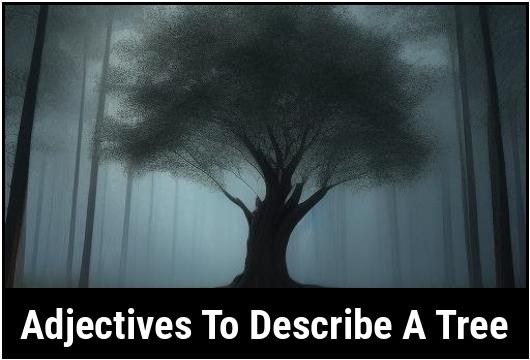- You are here:
- Home »
- adjectives
- » 41 Adjectives To Describe A Tree

41 Adjectives To Describe A Tree
Trees are magnificent, majestic, and vital components of our natural environment. They come in various shapes, sizes, and species, each possessing unique characteristics that make them distinctly remarkable. When we attempt to encapsulate the essence of a tree, the use of adjectives becomes indispensable. Adjectives have the power to vividly portray the beauty, strength, and essence of a tree, allowing us to appreciate and comprehend their significance. In this comprehensive guide, we will explore the various adjectives that can be used to describe a tree, why it is important to do so, and how to choose the right adjectives for the task.
Trees are not just mere objects in the natural world; they are living entities that play a crucial role in maintaining ecological balance, providing us with oxygen, sheltering diverse ecosystems, and adding splendor to our surroundings. Describing a tree using adjectives allows us to articulate its distinct features, characteristics, and overall impact. From the towering oak trees with their robust trunks to the delicate blossoms adorning a cherry tree, adjectives enable us to effectively convey the essence of these natural wonders.
Key Takeaways
- Adjectives are crucial in capturing the diverse and intricate attributes of trees.
- Through adjectives, we can articulate the visual, tactile, and emotional impact of trees.
- Describing trees with adjectives enhances our understanding and appreciation of their significance in the natural world.
Adjectives To Describe A Tree
1. Majestic
When we encounter a majestic tree, we cannot help but stand in awe of its grandeur. Its towering height, strong branches, and lush foliage create a sense of magnificence that commands attention.
2. Graceful
Some trees possess an inherent grace that is mesmerizing to behold. Their delicately arched branches and gentle sway in the breeze evoke a sense of elegance and poise.
3. Serene
A serene tree exudes tranquility, creating a peaceful and calming atmosphere in its vicinity. Its presence can bring about a sense of inner peace and contentment.
4. Sturdy
A sturdy tree stands firm against the elements, weathering storms and providing reliable shelter and support. Its solid trunk and robust branches convey a sense of durability and strength.
5. Vibrant
Trees that burst with vibrant colors are a sight to behold. From the vivid hues of fall foliage to the blooming blossoms of spring, these trees add a lively and energetic touch to their surroundings.
6. Ancient
An ancient tree carries with it a rich history, as it has stood witness to the passing of time. Its gnarled, weathered bark and well-established presence convey a sense of wisdom and longevity.
7. Harmonious
A harmonious tree seamlessly blends with its surroundings, fitting perfectly into the ecosystem it inhabits. Its balance of form, color, and size creates a sense of unity and cohesion.
8. Imposing
An imposing tree dominates the landscape, standing tall and proud. Its size and breadth command attention and respect, leaving an indelible impression on all who encounter it.
9. Enclosed
Some trees create a cozy enclosure with their dense branches and foliage, offering a sanctuary from the outside world. They provide shelter and a comforting sense of security.
10. Fragrant
Trees that emit a delightful fragrance enchant us with their alluring scents. From the sweet aroma of blossoming flowers to the fresh scent of pine, these trees engage our sense of smell.
11. Towering
A towering tree reaches great heights, soaring above other vegetation. Its lofty stature allows it to serve as a landmark and provides a sense of verticality to its surroundings.
12. Graceful
A graceful tree moves with fluidity and elegance, seemingly dancing in the wind. Its swaying branches create a captivating display that is both calming and captivating.
13. Rustling
The rustling of leaves provides a soothing symphony that can be attributed to certain varieties of trees. This characteristic adds an auditory dimension to the experience of being near them.
14. Resilient
Resilient trees have the ability to endure harsh weather conditions and adverse circumstances. Their ability to adapt and thrive in challenging environments is truly inspiring.
15. Serene
Trees have a serene quality that can infuse their surroundings with calmness and tranquility. Gazing at their branches as they sway gently can evoke a sense of relaxation and inner peace.
16. Towering
A towering tree not only commands attention but can also offer a unique perspective of the world from up above. Climbing to their heights rewards us with breathtaking views and a feeling of elevation.
17. Enchanting
Certain trees possess an enchanting quality that fills us with wonder and captivates our imagination. Their ethereal charm can transport us to a realm of fantasy and magical landscapes.
18. Vibrant
Vibrant trees fill our surroundings with energy and vitality, their abundant foliage providing a burst of color that invigorates the landscape. They bring life and vibrancy wherever they are found.
19. Delicate
Some trees have an intricate beauty that lies in their delicate features. Their slender branches and intricate patterns create an air of refinement and elegance.
20. Nurturing
Trees are often nurturing entities, providing a home and sustenance for a variety of creatures. From birds nesting in their branches to squirrels gathering acorns, they create a harmonious ecosystem.
21. Mighty
Mighty trees evoke a sense of power and dominance. Their strong trunks and expansive canopies bring forth images of majestic rulers of the natural world.
22. Dynamic
Trees are constantly changing and evolving, each season bringing a new display of color and growth. This dynamic nature adds an element of excitement and anticipation to their presence.
23. Inviting
Certain trees have an inviting quality that beckons us to explore their shade or bask in their beauty. They create a welcoming space that invites us to slow down and appreciate the world around us.
24. Magnificent
A magnificent tree possesses an awe-inspiring beauty that leaves us speechless. Its sheer splendor and visual impact are impossible to ignore, leaving us humbled in its presence.
25. Noble
A noble tree exudes dignity and a regal presence. Its tall stature and commanding appearance inspire respect and admiration.
26. Whimsical
Trees that appear to have a playful or fantastical quality bring a touch of whimsy to their surroundings. Their unique shapes or unusual growth patterns delight the imagination.
27. Enveloping
Some trees have a sprawling canopy that forms a protective and enveloping shelter below. Within this natural sanctuary, one may find solace and a sense of security.
28. Spirited
Trees can exhibit a spirited, lively aspect, seeming to possess a personality of their own. Their dynamic growth and animated movements give them a vivacious quality.
29. Eclectic
Eclectic trees boast a diverse array of characteristics, displaying a wide mix of textures, colors, and shapes. This makes them visually captivating and adds interest to any landscape.
30. Timeless
A timeless tree seems immune to the march of time, as if its beauty and appeal will remain eternal. Its enduring presence draws inspiration from the past and kindles hopes for the future.
31. Regenerating
Certain trees have the incredible ability to regenerate and grow anew after being damaged or cut. Their resilience and capacity for rebirth serve as a powerful metaphor for rejuvenation.
32. Spiraling
Trees that grow with an elegant and mesmerizing spiral pattern invite us to follow their intricate twists and turns with our eyes. They create a sense of mystery and intrigue.
33. Flaming
Some trees burst into flames of color during the autumn season, painting the landscape in fiery hues of red, orange, and gold. They ignite our senses and fill us with warmth.
34. Tenacious
Trees growing in hostile environments, such as rocky landscapes or arid regions, showcase a remarkable tenacity. They demonstrate the power of determination and resilience against all odds.
35. Evergreen
Evergreen trees, with their perpetual foliage, symbolize eternal life and everlasting beauty. They provide a constant source of greenery, even during the starkness of winter.
36. Sacred
Certain trees hold deep cultural or religious significance, being considered sacred in various traditions. They represent a connection to the divine and command reverence.
37. Patient
The slow growth of some trees shows great patience and deliberate progress over time. Their unhurried journey serves as a reminder of the value of patience and the rewards it brings.
38. Balancing
Trees possess a unique ability to bring balance to their surroundings, harmonizing the elements of nature. They provide shade, clean the air, and contribute to the overall well-being of ecosystems.
39. Inspirational
Trees have long served as a powerful source of inspiration for artists, poets, and thinkers alike. Their beauty, resilience, and connection to the natural world spark creativity and introspection.
40. Captivating
Trees have an innate ability to captivate our attention and draw us closer to nature. Whether it is their unique form, vibrant colors, or gentle movements, they have the power to fascinate and enchant.
41. Breath-taking
Finally, trees have the capacity to take our breath away, leaving us in awe of their sheer magnificence and splendor. Their impact on our senses and emotions is nothing short of breath-taking.
Why Use Adjectives To Describe A Tree
Adjectives serve as the palette with which we paint a vivid picture of a tree in the minds of others. When we describe a tree, we seek to convey its appearance, texture, size, age, and overall impression. Adjectives infuse our descriptions with color, texture, and emotion, enabling us to create a sensory experience. They provide a nuanced understanding and appreciation of the unique qualities that each tree possesses. Without the use of adjectives, our descriptions of trees would be bland, and the magnificence of these natural wonders would remain unexpressed and unappreciated.
How To Choose The Right Adjective To Describe A Tree
Selecting the right adjectives to describe a tree involves considering a range of factors, including its physical attributes, emotional impact, and the ambience it creates. Here are some key considerations when choosing adjectives to describe a tree:
1. Physical Characteristics
When describing a tree, observe its physical attributes—such as height, girth, shape, color, and foliage. These observations will inform your choice of adjectives. For instance, a towering redwood may be described as "massive," "towering," or "majestic," while a willow with graceful, drooping branches might be described as "graceful," "elegant," or "weeping."
2. Emotional Impact
Consider the emotional response evoked by the tree. Does it inspire awe, tranquility, or nostalgia? Adjectives such as "awe-inspiring," "serene," or "nostalgic" can effectively capture these emotional dimensions.
3. Overall Impression
Reflect on the overall impression the tree conveys. Does it exude strength, resilience, or gentleness? Adjectives like "strong," "resilient," "sturdy," "graceful," or "soothing" can be apt descriptors based on the tree’s overall impact.
By taking these factors into account, you can select adjectives that holistically represent the tree and convey its essence with depth and richness.
Types Of Adjectives For Describing A Tree
The range of adjectives available to describe a tree is vast and varied, encompassing a multitude of characteristics that capture the uniqueness of each tree. Here are several types of adjectives commonly used to vividly portray trees:
1. Visual Adjectives
Visual adjectives vividly portray the appearance of a tree, capturing its color, shape, and overall visual impact. Examples of visual adjectives include "towering," "gnarled," "verdant," "majestic," "striking," and "lush."
2. Textural Adjectives
Textural adjectives convey the tactile qualities of a tree’s bark, foliage, and overall texture. These adjectives allow the reader to envision the tactile experience of touching or embracing the tree. Examples of textural adjectives include "rough," "smooth," "knotted," "silken," "feathery," and "velvety."
3. Age-Related Adjectives
Adjectives related to age capture the maturity, longevity, and timelessness of a tree. They convey the wisdom and endurance that comes with age. Examples of age-related adjectives include "ancient," "timeless," "ageless," "centenarian," and "venerable."
4. Size And Scale Adjectives
These adjectives convey the imposing or diminutive scale of a tree, emphasizing its magnitude or subtlety. Examples of size and scale adjectives include "towering," "stout," "dainty," "gigantic," "sturdy," and "petite."
5. Emotion-Eliciting Adjectives
These adjectives evoke emotional responses in the reader, reflecting the feelings and sentiments inspired by the tree. Examples of emotion-eliciting adjectives include "breathtaking," "soothing," "enchanting," "serene," "grand," and "invigorating."
6. Seasonal Adjectives
Seasonal adjectives relate to the qualities of a tree that change with the seasons, such as its blossoms, foliage, or overall ambiance during different times of the year. Examples of seasonal adjectives include "blossoming," "foliage-clad," "snow-draped," "budding," "autumnal," and "springtime."
7. Species-Specific Adjectives
These adjectives are specific to certain tree species, capturing their unique characteristics and traits. Examples include "blossom-laden" for cherry trees, "evergreen" for conifers, "deciduous" for leaf-shedding trees, and "fragrant" for trees with aromatic blooms.
Adjectives are indispensable tools for articulating the essence, beauty, and significance of trees. By carefully selecting adjectives that capture the visual, textural, emotional, and overall impact of a tree, we can effectively communicate its splendor and importance. Whether it is a towering oak exuding an aura of strength, a delicate cherry blossom tree evoking tranquility, or a sprawling willow casting a serene ambiance, adjectives enable us to bring to life the enchanting world of trees. As we continue to cherish and protect our natural environment, let us remember the power of adjectives in illustrating the awe-inspiring marvels that trees represent.
Examples Of Adjectives For Different Types Of Tree
When it comes to describing a tree, the right choice of adjectives can bring it to life in the reader’s mind. Adjectives are important because they provide additional details and characteristics that enhance the overall description of the tree. By carefully selecting adjectives, you can paint a vivid picture of the tree’s appearance, size, shape, texture, and overall beauty.
-
Tall:
A towering tree that reaches great heights, standing tall and proud. This adjective is often used to describe trees like redwoods or sequoias. -
Sturdy:
A tree that is strong and reliable, able to withstand harsh weather conditions. This adjective is commonly used for oak or maple trees. -
Majestic:
This adjective conveys a sense of grandeur, elegance, and dignity. It is often used to describe trees with a regal appearance, such as magnolias or weeping willows. -
Lush:
A tree that is full of healthy, vibrant foliage, giving it a lush and full appearance. This adjective is suitable for describing trees like the Japanese maple or the banyan tree. -
Graceful:
This adjective captures the elegance and beauty of a tree, often used to describe trees with delicate branches and swaying leaves, such as birch or willow trees. -
Dense:
A tree that has thick foliage or a high concentration of branches and leaves. This adjective is often used to describe trees like evergreens or cedar trees. -
Blossoming:
A tree that is covered in blooms or flowers, adding color and vibrancy to its appearance. This adjective is commonly used for cherry blossom trees or apple trees during their blooming season. -
Rustling:
A tree that makes a soft, whispering sound when the wind blows through its leaves. This adjective adds an auditory quality to the description and is often used for trees like aspen or poplar trees. -
Ancient:
A tree that has existed for a long time, conveying a sense of age, wisdom, and history. This adjective is often used to describe trees like the oak or cedar trees. -
Vibrant:
A tree that exhibits intense or bright colors, often used to describe trees with colorful foliage, such as the sugar maple or dogwood trees during the fall season. -
Delicate:
A tree that has fragile branches or leaves, creating a sense of fragility or vulnerability. This adjective is often used to describe trees like the cherry blossom or mimosa tree. -
Serene:
A tree that creates a peaceful and tranquil atmosphere around it, often used to describe trees with gently swaying branches and calm surroundings, such as willow or birch trees. -
Towering:
A tall and imposing tree that stands above the surrounding trees or landscape. This adjective is often used to describe trees like the redwood or pine trees. -
Whimsical:
A tree that has a playful, fanciful, or unusual appearance, often used to describe trees with unique shapes or curves, such as the bonsai tree or corkscrew willow. -
Picturesque:
A tree that is visually pleasing and attractive, often used to describe trees with a combination of colors, textures, and shapes, such as the jacaranda tree or the flowering dogwood.
Common Mistakes In Using Adjectives To Describe Tree
While adjectives can be powerful tools for describing trees, it is important to use them carefully to avoid common mistakes. Here are some common errors to avoid:
-
Overusing adjectives:
Using too many adjectives can overwhelm the reader and make the description feel cluttered. It is best to select a few well-chosen adjectives that capture the essence of the tree, rather than using a long string of adjectives. Choose quality over quantity.Example of Overuse: "The tall, sturdy, majestic, lush, graceful, dense tree with blossoming flowers and rustling leaves stood in the ancient, vibrant, delicate forest."
Revised Version: "The majestic, blossoming tree stood tall in the ancient forest."
-
Using generic adjectives:
Generic adjectives, such as "nice" or "beautiful," do not provide specific details about the tree and can weaken the overall description. Instead, opt for more specific and evocative adjectives that paint a vivid picture in the reader’s mind.Example of Generic Adjective: "The tree was beautiful."
Revised Version: "The tree was vibrant, with its colorful foliage and delicate branches."
-
Being inconsistent:
It is important to be consistent in the choice of adjectives throughout the description. Mixing contrasting or conflicting adjectives can confuse the reader and create a disjointed description. Make sure that the adjectives you choose are coherent and create a cohesive image.Example of Inconsistency: "The tree was tall and sturdy, but also delicate and fragile."
Revised Version: "The tree stood tall and sturdy, with its branches reaching towards the sky."
-
Not considering the context:
When describing a tree, it is crucial to consider the specific type of tree, its environment, and the intended mood or atmosphere of the description. Using adjectives that are inappropriate or contradictory to the context can weaken the overall effect.Example of Inappropriate Context: Describing a towering redwood tree as "small" or "insignificant."
Revised Version: "The towering redwood tree dominated the forest, its grandeur awe-inspiring."
Using Adjectives Effectively
-
Choose specific and descriptive adjectives:
Adjectives should convey precise details about the tree, such as its size, shape, texture, color, or overall character. Select adjectives that provide a clear and vivid image of the tree in the reader’s mind. Instead of using generic adjectives, be specific and use words that paint a more detailed picture.Example: Instead of saying "The tree had green leaves," you could say, "The tree had luscious emerald green leaves that shimmered in the sunlight."
-
Consider the sensory experience:
Adjectives can not only describe the visual aspects of the tree but also evoke the other senses, such as touch or sound. Think about how the tree feels, sounds, or even smells, and incorporate sensory adjectives to create a more immersive experience for the reader.Example: "The tree’s rough bark felt like ancient armor, and the sound of wind rustling through its leaves was a soothing lullaby."
-
Vary your adjectives:
To avoid repetitive language and add depth to your description, use a variety of adjectives to capture different aspects of the tree. Experiment with different adjectives that emphasize different qualities, such as size, age, shape, or overall atmosphere.Example: Instead of repeatedly using the adjective "tall," you could describe the tree as "towering," "lofty," or "giant."
-
Use figurative language:
Incorporating figurative language, such as metaphors or similes, can make your description more vivid and engaging. By comparing the tree to something else, you can create a stronger impact and add a layer of meaning to your description.Example: "The branches of the willow tree cascaded downwards like a graceful dancer, their flowing movements captivating all who beheld them."
-
Show, don’t tell:
Instead of simply stating facts about the tree, try to show its characteristics through carefully selected adjectives. Use adjectives that evoke a specific image or feeling and allow the reader to imagine the tree’s appearance and presence.Example: Instead of saying "The tree was old," you could say, "The tree stood tall, its gnarled branches reaching out like ancient storytellers, whispering tales of a bygone era."
Exercises And Practice
To enhance your skills in using adjectives to describe trees, here are some exercises and practice activities you can try:
-
Observation Exercise:
Go for a walk in a park or forest and take note of the different types of trees you see. Observe their physical characteristics, such as size, shape, foliage, and overall appearance. Use descriptive adjectives to describe each tree in your notebook, focusing on their unique qualities and details. -
Writing Prompts:
Write short descriptions of trees using the provided writing prompts. Practice incorporating adjectives that effectively capture the essence of each tree.a. Describe a willow tree near a serene lake.
b. Describe a towering pine tree in a thick forest.
c. Describe a blooming cherry blossom tree in a Japanese garden.
d. Describe an ancient oak tree with twisted branches. -
Peer Feedback:
Share your descriptions with a peer or writing group and ask for feedback. Discuss the effectiveness of the chosen adjectives, the imagery they create, and any areas for improvement. Incorporate the feedback to refine your descriptions further.
FAQS On Adjectives To Describe A Tree
What Are Some Common Adjectives Used To Describe Trees?
Some common adjectives used to describe trees are towering, majestic, verdant, sturdy, and leafy.
How Can We Accurately Describe The Size Of A Tree?
The size of a tree can be accurately described by using adjectives such as massive, immense, enormous, or colossal.
What Are Some Ways To Describe The Shape Of A Tree?
The shape of a tree can be described using adjectives such as sprawling, gnarled, symmetrical, or asymmetrical.
How Can We Convey The Age Of A Tree With Adjectives?
The age of a tree can be conveyed through adjectives such as ancient, mature, young, or youthful.
What Are Some Descriptive Adjectives For The Overall Appearance Of A Tree?
The overall appearance of a tree can be described using adjectives such as graceful, picturesque, majestic, or elegant.








